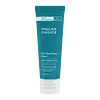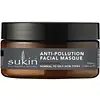What's inside
What's inside
 Key Ingredients
Key Ingredients

 Benefits
Benefits

 Concerns
Concerns

 Ingredients Side-by-side
Ingredients Side-by-side

Water
Skin ConditioningKaolin
AbrasiveBentonite
AbsorbentGlycerin
HumectantSalix Alba Extract
Skin ConditioningStearic Acid
CleansingSteareth-2
EmulsifyingAloe Barbadensis Leaf Juice Powder
Skin ConditioningSea Whip Extract
Skin ConditioningColloidal Oatmeal
AbsorbentBisabolol
MaskingAscorbyl Palmitate
AntioxidantTocopheryl Acetate
AntioxidantPhospholipids
Skin ConditioningPanthenol
Skin ConditioningRetinyl Palmitate
Skin ConditioningCaprylyl Glycol
EmollientButylene Glycol
HumectantEthylhexylglycerin
Skin ConditioningHexylene Glycol
EmulsifyingDisodium EDTA
Phenoxyethanol
PreservativeWater, Kaolin, Bentonite, Glycerin, Salix Alba Extract, Stearic Acid, Steareth-2, Aloe Barbadensis Leaf Juice Powder, Sea Whip Extract, Colloidal Oatmeal, Bisabolol, Ascorbyl Palmitate, Tocopheryl Acetate, Phospholipids, Panthenol, Retinyl Palmitate, Caprylyl Glycol, Butylene Glycol, Ethylhexylglycerin, Hexylene Glycol, Disodium EDTA, Phenoxyethanol
Water
Skin ConditioningKaolin
AbrasiveBentonite
AbsorbentStearic Acid
CleansingCetyl Alcohol
EmollientCetearyl Alcohol
EmollientGlyceryl Stearate
EmollientCaprylic/Capric Triglyceride
MaskingCeteareth-20
CleansingPersea Gratissima Oil
Skin ConditioningRosa Canina Fruit Oil
EmollientCharcoal Powder
AbrasiveBiosaccharide Gum-4
Skin ConditioningCydonia Oblonga Leaf Extract
Skin ConditioningCocos Nucifera Oil
MaskingAloe Barbadensis Leaf Juice
Skin ConditioningCucumis Sativus Fruit Extract
EmollientMoringa Oleifera Leaf Extract
Skin ConditioningAspalathus Linearis Leaf Extract
Skin ConditioningChamomilla Recutita Flower Extract
MaskingEpilobium Angustifolium Extract
Skin ConditioningPunica Granatum Fruit Extract
AntioxidantVaccinium Myrtillus Fruit Extract
Skin ConditioningGlycerin
HumectantTocopherol
AntioxidantXanthan Gum
EmulsifyingCitrus Nobilis Peel Oil
MaskingLavandula Angustifolia Oil
MaskingBackhousia Citriodora Leaf Oil
MaskingCitrus Aurantifolia Oil
CleansingCitrus Aurantium Amara Leaf/Twig Oil
MaskingCitric Acid
BufferingPhenoxyethanol
PreservativeBenzyl Alcohol
PerfumingLimonene
PerfumingLinalool
PerfumingWater, Kaolin, Bentonite, Stearic Acid, Cetyl Alcohol, Cetearyl Alcohol, Glyceryl Stearate, Caprylic/Capric Triglyceride, Ceteareth-20, Persea Gratissima Oil, Rosa Canina Fruit Oil, Charcoal Powder, Biosaccharide Gum-4, Cydonia Oblonga Leaf Extract, Cocos Nucifera Oil, Aloe Barbadensis Leaf Juice, Cucumis Sativus Fruit Extract, Moringa Oleifera Leaf Extract, Aspalathus Linearis Leaf Extract, Chamomilla Recutita Flower Extract, Epilobium Angustifolium Extract, Punica Granatum Fruit Extract, Vaccinium Myrtillus Fruit Extract, Glycerin, Tocopherol, Xanthan Gum, Citrus Nobilis Peel Oil, Lavandula Angustifolia Oil, Backhousia Citriodora Leaf Oil, Citrus Aurantifolia Oil, Citrus Aurantium Amara Leaf/Twig Oil, Citric Acid, Phenoxyethanol, Benzyl Alcohol, Limonene, Linalool
 Reviews
Reviews

Ingredients Explained
These ingredients are found in both products.
Ingredients higher up in an ingredient list are typically present in a larger amount.
Bentonite is an aluminium phyllosilicate clay with great absorbent properties. The name 'bentonite' comes from the area where the largest source is found: Fort Benton, Wyoming.
As a clay, bentonite is often used to absorb excess oil and provide exfoliation. It has also been shown to have some antibacterial and anti-inflammatory properties. Studies show bentonite was effective at calming dermatitis from poison ivy and in diaper dermatitis of infants. Bentonite has also been shown to act as a barrier against toxic compounds on your skin.
Sunscreens containing bentonite display higher water resistance and stay on the skin for much longer. The sunscreens containing bentonite also show higher potency and UV light absorbtion.
Bentonite is naturally created from volcanic ash and several natural weathering/hydrothermal processes.
A common usage of bentonite is removing excess protein from white wines. Bentonite contains a property of being able to absorb large amounts of protein from aqueous solutions.
Phyllosilicate clay has a structure formed by sheets.
Learn more about BentoniteGlycerin is already naturally found in your skin. It helps moisturize and protect your skin.
A study from 2016 found glycerin to be more effective as a humectant than AHAs and hyaluronic acid.
As a humectant, it helps the skin stay hydrated by pulling moisture to your skin. The low molecular weight of glycerin allows it to pull moisture into the deeper layers of your skin.
Hydrated skin improves your skin barrier; Your skin barrier helps protect against irritants and bacteria.
Glycerin has also been found to have antimicrobial and antiviral properties. Due to these properties, glycerin is often used in wound and burn treatments.
In cosmetics, glycerin is usually derived from plants such as soybean or palm. However, it can also be sourced from animals, such as tallow or animal fat.
This ingredient is organic, colorless, odorless, and non-toxic.
Glycerin is the name for this ingredient in American English. British English uses Glycerol/Glycerine.
Learn more about GlycerinKaolin is a clay. It is used for oil control and to help minimize pores. Like other clays, kaolin has the ability to absorb excess sebum or oil. This can help clean out pores and mattify the skin.
Some types of kaolin may have exfoliating properties. When water is added to kaolin, it becomes a paste with small abrasive particles.
Most kaolin is a white color, but may be pink/orange/red depending on where it comes from.
The name 'kaolin' comes from a Chinese village named 'Gaoling'. Kaolin clay comes from rocks rich in kaolinite. Kaolinite, the mineral, has a silicate layered structure. Kaolinite is formed from chemical weathering of aluminum siilicate minerals.
Besides skincare, kaolin is commonly used to make glossy paper, in ceramics, toothpaste, and as medicine to soothe stomach issues.
Learn more about KaolinPhenoxyethanol is a preservative that has germicide, antimicrobial, and aromatic properties. Studies show that phenoxyethanol can prevent microbial growth. By itself, it has a scent that is similar to that of a rose.
It's often used in formulations along with Caprylyl Glycol to preserve the shelf life of products.
Stearic Acid is a fatty acid. It is an emollient, emulsifier, and texture enhancer.
As an emollient, stearic acid helps soften skin. It aids the skin's protective barrier by preventing water loss. It also provides a gentle cleansing effect without stripping away natural oils.
Stearic acid may also be used to enhance the texture of products. It can add volume and stabilize ingredients such as water and oil. This can help water and oil ingredients from separating.
Sources of stearic acid include animal or vegetable fats/oils such as coconut or shea. It can be naturally found in butter, cocoa butter, shea butter, vegetable fats, and animal tallow.
This ingredient may not be Malassezia folliculitis, or fungal-acne safe.
Learn more about Stearic AcidWater. It's the most common cosmetic ingredient of all. You'll usually see it at the top of ingredient lists, meaning that it makes up the largest part of the product.
So why is it so popular? Water most often acts as a solvent - this means that it helps dissolve other ingredients into the formulation.
You'll also recognize water as that liquid we all need to stay alive. If you see this, drink a glass of water. Stay hydrated!
Learn more about Water